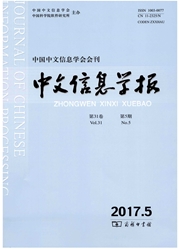

 中文摘要:
中文摘要:
否定义是深层语义表示中的一个重要组成部分。该文基于语料库的方法对现代汉语中的否定表达形式及其使用规律进行深入分析。首先,系统地收集否定表达形式,将之分为显性否定词、隐性否定词、否定结构三类,并讨论否定表达形式的非否定用法。其次,对否定表达形式的使用规律进行归纳与总结,涉及单动核结构、情态成分、述补结构、动词性并列结构、连谓结构、兼语结构等,重点分析多动核结构中否定对命题义的影响,并总结在深层语义标注框架下否定义的标注规则。最后,基于多领域句法树库考察否定表达形式的领域分布差异。
 英文摘要:
英文摘要:
Negative expression plays an important role in deep semantic representation.Using corpus-based methods,this paper focuses on analyzing negative expressions and their usages in contemporary Chinese.First,we collect negative expressions and classifiy them into three types,i.e.explicit negatives,implicit negatives and negative constructions.Second,we analyze the rules of negative expressions,covering those used in modifying single-predicate structures,modality elements,predicate-complement structures,verbal coordinate structures,serial verb structures and pivotal sentences,we especially focus on discussing the effect of negative expressions in multi-predicate structures upon the meanings of propositions.The annotation scheme is also developed under the deep semantic representation framework.Finally,we investigate the distribution of negative expressions in multi-domain treebanks.
 同期刊论文项目
同期刊论文项目
 同项目期刊论文
同项目期刊论文
 期刊信息
期刊信息
